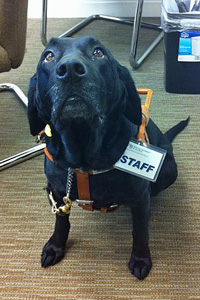[Editor's note: The following blog comes from Paige, a Dog Guide here at AFB headquarters. Paige is here to share a few thoughts on what to do when you encounter a visually impaired person and his or her dog guide.]
Hi! I'm Paige, and I'm a Dog Guide. You may also hear of us referred to as "Seeing Eye Dogs" and "Guide Dogs," but we do prefer Dog Guides - after all, we're dogs first!
Since my master is currently occupied – she's a rather busy woman—I'd thought I'd use my down time to discuss what my colleagues and I do for a living. Because—make no mistake—this is our job, and a pretty darn important one at that.
Dog guides are carefully trained service animals used as travel tools by people who are blind or visually impaired. That's it in a nutshell, but the devil is in the details.
Dog guides and their masters undergo rigorous training together to work safely and effectively as a team. People who are blind—our masters—are responsible for our health and well-being at all times. We should be (and normally are) always kept under control by our masters. (And yes, this includes the occasional "accident" or "mess." Like I said, we're dogs first...)
We work most effectively with people who have very limited vision. It's likely that most dog guide users you'll meet are totally blind.
When we travel with our masters, we move only in response to our masters' directions—we only disobey commands to avoid—yikes!—danger.
Trust me, concentration is essential when people travel with their dog guides. If you see us guiding a person who's blind, please do not interact with us! We're working! Sure, we're cute and all, but petting, feeding, or any sort of distraction is not only inappropriate, it's potentially dangerous. You certainly wouldn't want people coming up to you, talking in a baby-voice and touching you while you were hard at work. It's a simple courtesy and, for my part, it's much appreciated.
Thanks for listening. Since my master is still busy at work, I think I'll take a nap.
